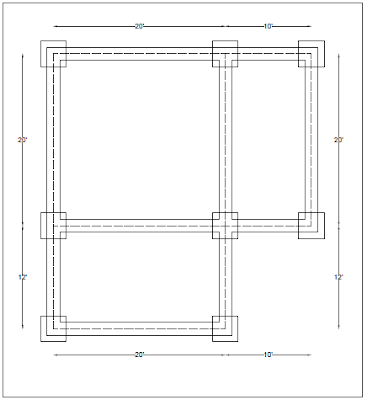When we analyse a rate for construction work, we can get different answers according the previous records which have been recorded during construction period. Since the theoretical answer is the same for everyone, it shall be vary due to material quality, wastage, transport and limitation to the work, etc. The other major factor is the labour cost. For an example, the area can be covered for a certain work might be different for one another. It depends on the skill level and the work experiences.
Rate Analysis for Brick Work - 225mm thick (Ground Floor Level)
Required number of brick (Size 215x112.5x65mm) for 9.29m2 = 1090 Nr
Required number of cement bags (50kg) for 9.29m2 = 4 Nr
Required volume of sand for 9.29m2 = 0.3 Cu
As per the previous field records;
1 mason and 1 labour can cover approximately 6.5m2 per day (8 hr). Let's say to cover 9.29m2, it takes 1.43 mason days and 1.43 labour days. Assume mason charge 2500 LKR per day and labour charge 1600 LKR per day.
Total Labour Cost = 5,863.00LKR/9.29m2
Therefore labour cost for 1 m2 = 631.11 LKR
Assume cost of a brick is 13 LKR, Cement bag = 950 LKR and sand cube 13000 LKR.
Total cos of Material = 14170 LKR + 3800 LKR + 3900 LKR
= 21870 LKR
Allow;
Wastage for brick 7.5% = 1062.75 LKR
Wastage for sand 10% = 390 LKR
Acutual cost of material = 233322.75 LKR/ 9.29m2
Hence cost for 1m2 = 2167.50 LKR
Now for the above rate, we need to add and apply the cost of necessary scafoldings, Tools & equipment hiring charges in the market. Usually, we add 3% of labour cost for the above.
Therefore charges for scafoldings, tools & equipment hiring charges for 1m2 would be = 18.93 LKR
Now we can sum the cost of Labour, Material and Equipment hiring charges to get the actual working cost of 1m2 of 9" thick brick work as follows;
Total cost = 2817.54 LKR/m2
Please note the above cost is indicated for the direct labour and cost can be vary due to wastage as I mentioned in the beginning of the paragraph.
Rate Analysis for Brick Work - 225mm thick (Ground Floor Level)
Required number of brick (Size 215x112.5x65mm) for 9.29m2 = 1090 Nr
Required number of cement bags (50kg) for 9.29m2 = 4 Nr
Required volume of sand for 9.29m2 = 0.3 Cu
As per the previous field records;
1 mason and 1 labour can cover approximately 6.5m2 per day (8 hr). Let's say to cover 9.29m2, it takes 1.43 mason days and 1.43 labour days. Assume mason charge 2500 LKR per day and labour charge 1600 LKR per day.
Total Labour Cost = 5,863.00LKR/9.29m2
Therefore labour cost for 1 m2 = 631.11 LKR
Assume cost of a brick is 13 LKR, Cement bag = 950 LKR and sand cube 13000 LKR.
Total cos of Material = 14170 LKR + 3800 LKR + 3900 LKR
= 21870 LKR
Allow;
Wastage for brick 7.5% = 1062.75 LKR
Wastage for sand 10% = 390 LKR
Acutual cost of material = 233322.75 LKR/ 9.29m2
Hence cost for 1m2 = 2167.50 LKR
Now for the above rate, we need to add and apply the cost of necessary scafoldings, Tools & equipment hiring charges in the market. Usually, we add 3% of labour cost for the above.
Therefore charges for scafoldings, tools & equipment hiring charges for 1m2 would be = 18.93 LKR
Now we can sum the cost of Labour, Material and Equipment hiring charges to get the actual working cost of 1m2 of 9" thick brick work as follows;
Total cost = 2817.54 LKR/m2
Please note the above cost is indicated for the direct labour and cost can be vary due to wastage as I mentioned in the beginning of the paragraph.

